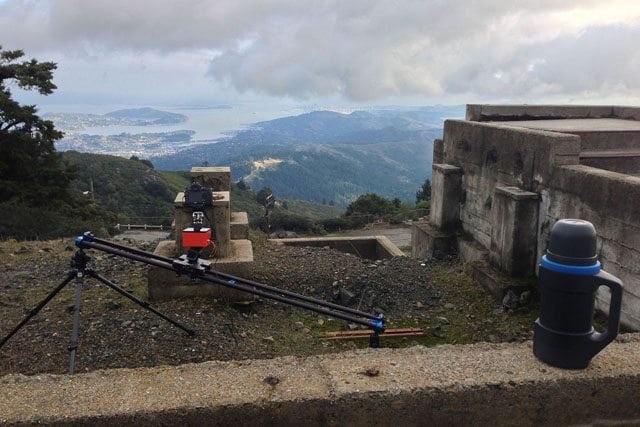

Read part one of this blog series.
Preparation: Over the past two months I’ve been busy conducting initial tests of new motion-control equipment I’ve acquired for creating the time-lapse portion of the project. One of my frustrations with the two-foot slider I used in the Fire Lookout piece is that it wasn’t long enough to provide enough visual parallax cues to make larger scenes look three-dimensional. These parallax cues are essential to providing an immersive sense of the scene because when the camera is moving, closer objects will move across your visual field much more quickly than objects farther away. When shooting basic time-lapse sequences you can easily lock the camera down on a tripod and shoot a frame every few seconds. That’s easy to do, but to get parallax effects you need to mount the camera on a motorized slider that will move it a fraction of an inch after every shot. This technique was invented by Ron Fricke in the late 1970s for the groundbreaking film Koyannisqatsi, and then refined for his later masterpieces, Chronos, Baraka, and 2012’s Samsara.
I was lucky to be invited by Ron to stay at his studio in Venice Beach for a few days in 1978 and was awed by his creative drive and imagination. I always dreamt of being able to create those kinds of images and finally the equipment for doing these things is now available “off the shelf” and at reasonable prices. A SF entrepreneur named Brian Burling started a small company called eMotimo to make inexpensive time-lapse gear and I bought his TB3 unit, which has two motors for panning and tilting the camera. It has a third control channel for sliding the camera along a straight path and I bought a set of six-foot-long rails, a “sled,” and a stepper motor from Dynamic Perceptions for that third control channel. This is what the DPS1/TB3 rig looks like in the field.
Once I had all that working I was comfortable that I could get started. Examples of each of those rigs can be seen here.
Now that I knew I could accomplish the time-lapse sequences I needed, I started to focus on how to tell the story of West Peak. There are significant people and events in the history of the mountain and the idea is to connect to them and make it real. These include:
I need to pull all of these elements together to make a cohesive and inspiring story.
The most important step in creating a film is to write what’s called a “treatment,” which is a prosaic telling of the story that provides clarity about the project’s intent. It’s a start-to-finish summary that takes what’s in the filmmakers mind and puts it on a page in black-and-white so that everyone involved in the project is conceptually together. I’d never written a treatment before but found that the process of doing it was extremely clarifying and now, as I edit drafts of the treatment, I’m refining my ideas and distilling them down to the most-important issues.
I’m not going to share the treatment drafts in this blog yet because it’s still a living document and I don’t want to get pinned down to anything specific while things are in flux. But by the end of the project, I’ll share it and I’ll talk about how it developed over time.

